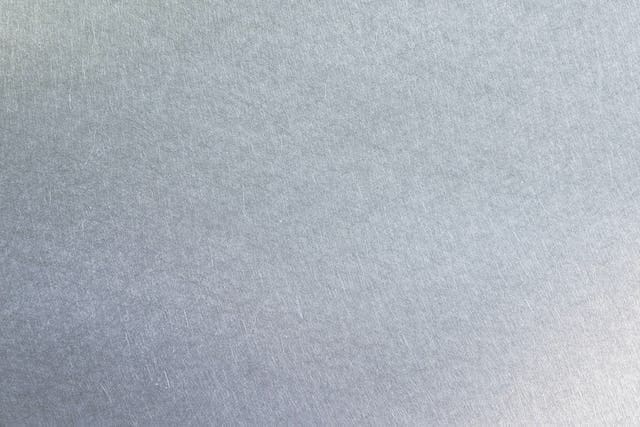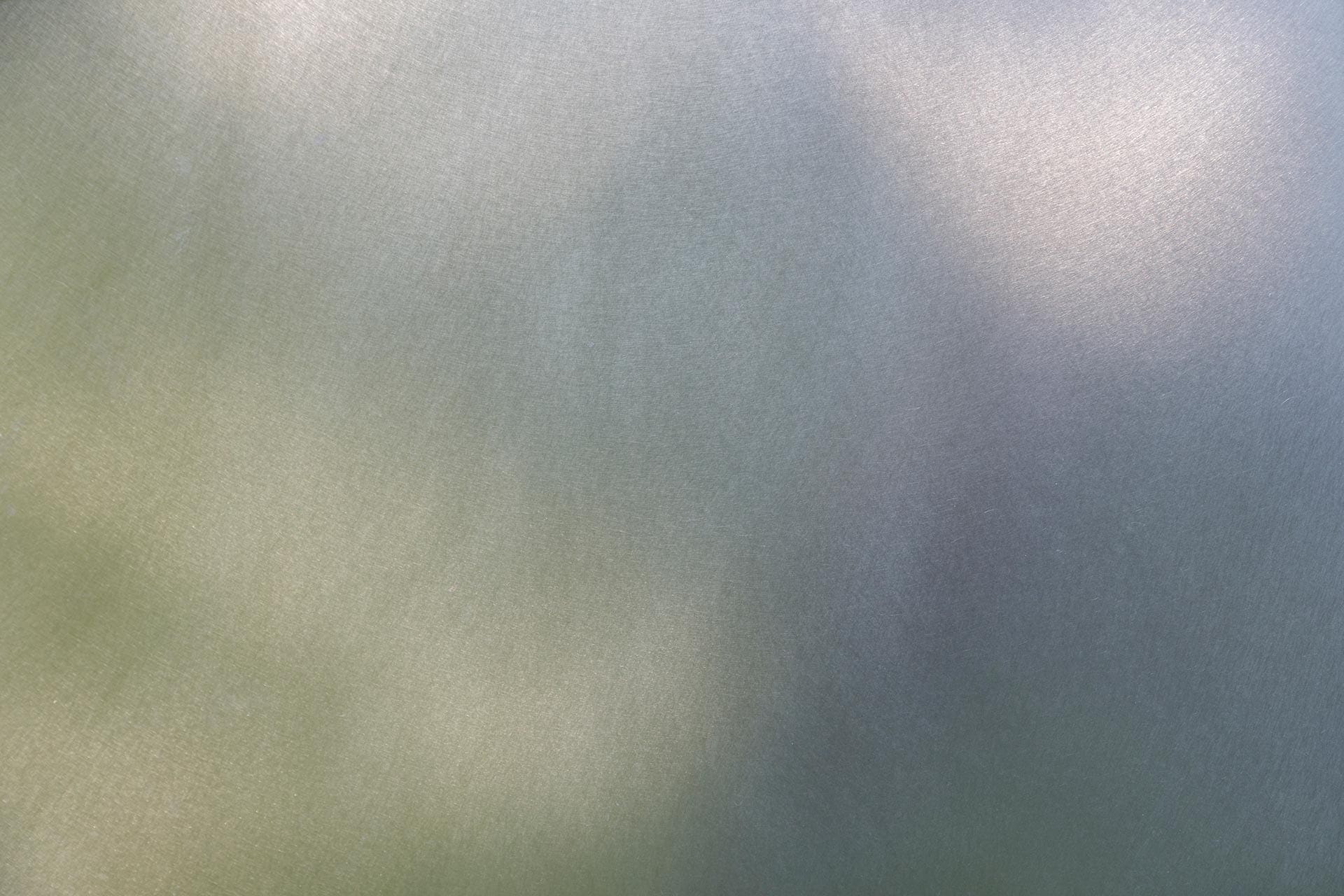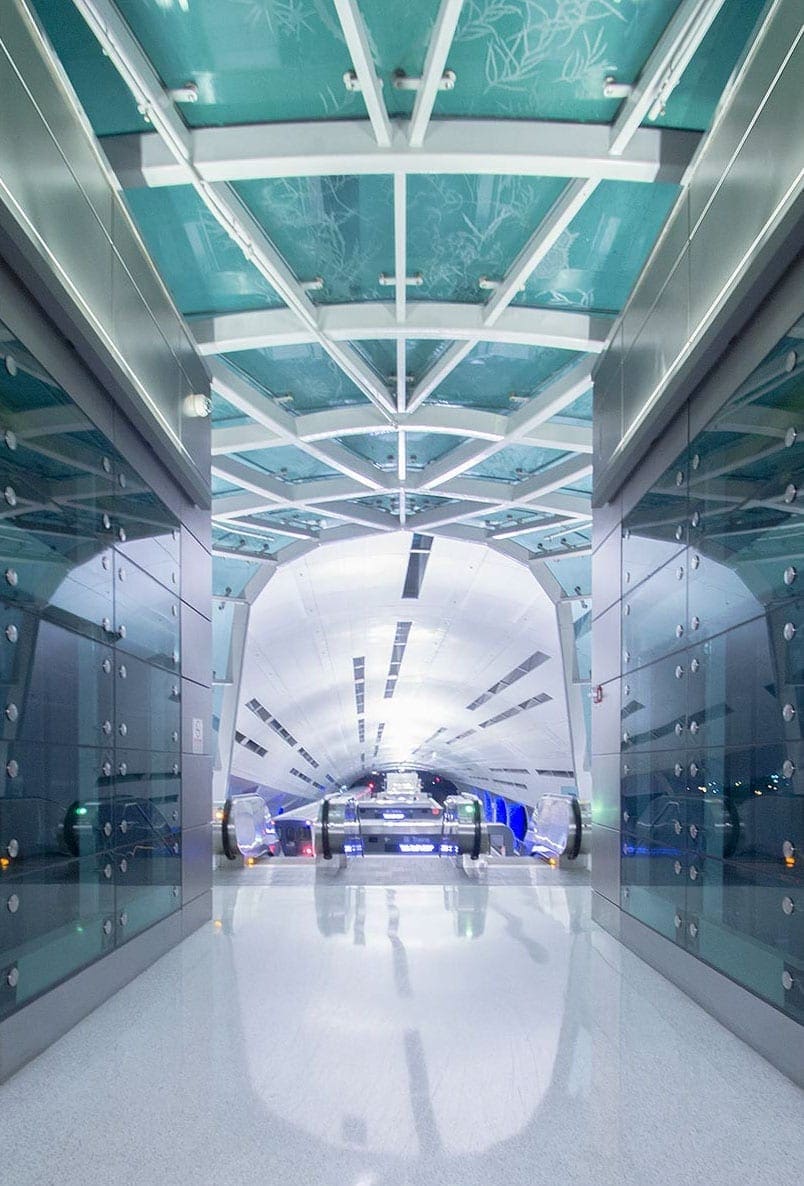Stainless Steel Guide Part 3: The Latest Architectural Innovations & Applications of Stainless Steel
An exploration of the advanced applications and immense possibilities of stainless steel.
This is the final installation of our three-part series on stainless steel. Read about the history of stainless steel in part 1 and the finishes and colors of stainless steel in part 2.
Durable, recyclable, and easy to maintain, stainless steel is celebrated across industries where toughness and corrosion resistance are paramount.
However, the single greatest attribute of a stainless steel surface may be its interplay with light. Stainless steel reflects approximately 60% of a light wave. The luster generated by the absorption and reemission of the light wave intensifies the appearance.
The ability to finish and change the surface reflectivity of the metal enables the artist to create with light. Consider the mesmerizing sculpture by Walter De Maria, The Lightning Field. Here, Walter De Maria used 400 polished stainless steel rods spaced over a square mile in the desert of southwest New Mexico. The stainless steel rods capture the light and the viewer sees lines of light as the rods recede into the distance.
Over the years, Zahner has worked to amplify this interplay of light. Through patented fabrication systems we have developed Angel Hair®—the finest, smoothest, and most uniform light-diffusion metal surface available for architectural metal—as well as GB-60™, a mechanical finish for metal with a diffused, non-directional appearance.
Let’s take a closer look at these innovations in stainless steel and examine the Zahner projects that scale up the possibilities of this remarkable material.
The Richard B. Fisher Center for the Performing Arts at Bard College, featuring Zahner Angel Hair.
PHOTO © A. ZAHNER COMPANY.The Stainless Steel Surface Without Inconsistencies
True Angel Hair finish is a velvety, consistent, and elegant surface. From sheet to sheet and edge to edge, this finish is like the threads in a fine suit.
Zahner Angel Hair was developed while working with the great architect Frank Gehry. He wanted a finish that was more refined than a mill surface, a finish that would disperse light while still possessing the luster and tone of a natural surface.
There was “vibration” stainless steel (which had an Angel Hair-like finish), first introduced in the 1980s by the Japanese. But the process produced striping and other uneven finish problems. So in 1998, Zahner came up with a patented, non-directional stainless steel finish, Angel Hair, with no striping.
Angel Hair® Stainless Steel by Zahner.
PHOTO © A. ZAHNER COMPANY."Vibration" finish offered by industry manufacturers.
PHOTO © A. ZAHNER COMPANY.OHR-O'KEEFE MUSEUM OF ART WITH SKINS FEATURING ANGEL HAIR STAINLESS STEEL.
PHOTO © A. ZAHNER COMPANY.True Angel Hair
Initially there were several competitive non-directional finishes on the market, each with subtle differences in reflectivity. The difficulty was in removing the mottling effect that could be seen when the surface was observed from a distance. Overlapping patterns, such as scallops, would appear, or striping patterns from the lapping process.
Additionally, copies of Angel Hair are often produced by hand. This results in a mottled, inconsistent surface. There is no way around this when the finish is applied manually.
Pressure differences and symmetrical movements of the discs used to apply the finish will create these ghosting effects. Up close all looks good, however, observe the surface from a distance and the scallop or lines appear.
True Angel Hair is a dual surface: one level of texture below another. The small circular scratches are induced in such a way that symmetry is disrupted, eliminating the striping and scalloping effects.
Detail of the Angel Hair stainless steel surface on the Fisher Center at Bard College.
Photo © A. Zahner Company.Benefits Of Zahner Angel Hair®
The main benefit of this finish is its interaction with light. The small arching scratches effectively scatter light and produce a diffuse reflection possessing different qualities when viewed up close or at a distance.
Another major benefit is that these finishes are repairable and easy to blend around welds. In reality, that is where the finish was born. Repairing automobile dents, finishing welded sections of steel, and even the sanding of wood floors all use an electric sander that vibrates in tight swirls.
This works well when finishing localized edges or preparing for paint and varnishes. But this hand process produces a mottled, irregular appearance on stainless steel surfaces of size or for a series of panel elements assembled to create a large area.
There are many techniques used today to produce the Zahner Angel Hair surface. Advancements in robotics have taken the finishing process in a new direction that maintains control and quality and eliminates the disturbing patterns created by low-quality production.
Semi-automated machines were developed to produce the finish for architectural surfaces. The Zahner Angel Hair process uses a patented device that breaks the symmetry of the repeating arc.
THE ZAHNER TEAM INSPECTING THE ANGEL HAIR EYEBROWS AT BAY VIEW DURING CONSTRUCTION.
PHOTO © A. ZAHNER COMPANY.Zahner Angel Hair eyebrows and Google's custom-designed dragonscale solar skin roofing.
PHOTO © A. ZAHNER COMPANY.Angel Hair Stainless Steel In Zahner Projects
Zahner has utilized the consistent luster of Angel Hair in countless projects. There’s the “Smile” trusses and clerestory windows at Google HQ, accented by architectural eyebrows made from Angel Hair Stainless Steel.
Rogers Place Arena Exterior Facade
Photo by Devin Sheremeta | ARKOAs well as the 212,000 square feet of custom Angel Hair panels supplied by Zahner to form the geometric controlled edges of Rogers Place Arena in Edmonton, Alberta.
Cooper Union New Academic Building in Manhattan.
Photo © A. Zahner Company.Focused on sustainability, The Cooper Union’s 41 Cooper Square building in downtown Manhattan utilized perforated sheets with an Angel Hair finish to control sunlight penetration during warm weather, and to act as an insulating barrier in cold weather.
Miami Intermodal Center metal clad ZEPPS® panels with Angel Hair® Stainless Steel.
PHOTO © A. ZAHNER COMPANYMIAMI INTERMODAL CENTER
PHOTO © A. ZAHNER COMPANYPhotograph of a train leaving the Miami Intermodal Center.
Photo © A. ZAHNER COMPANYBecause of its proximity to the Atlantic ocean (and threats of hurricane damage), The Miami Intermodal Center chose stainless steel for its durability. An Angel Hair finish was added to create a gentle glow on the sturdy metal surface.
GB-60™ | The Patented Glass Bead Blasted Stainless Steel
GB-60 is another non-directional Zahner innovation first developed for architectural applications requiring diffuse reflectivity. Its origin, like many advancements in metallurgy, can be found in the industrial age.
In the late 1800s, a patent was filed by Benjamin Chew Tilghman for an abrasive blasting technique to be used on bottles, cleaning boilers, and bringing out the grain in wood. Tilghman had supposedly seen the effect of wind-blown sand on glass while a general in the United States Army.
Nearly a century later in the 1990s, the bead-blasting technique had been used in a number of industries. Stainless steel is well suited for glass bead blasting, which impacts the surface of with minute glass beads. These beads, striking the surface with significant energy, will impart tiny, overlapping concave dishes across the entire surface of the stainless steel.
KAUFFMAN CENTER FOR THE PERFORMING ARTS clad in GB-60 stainless steel.
PHOTO © Drone & Film StudiosStriating stainless steel panel system used on the 911 Museum facade.
Photo © A. Zahner Company.Sunlight activates the louvered perforated facade on the Dolby Labs Headquarters in San Francisco, California.
PHOTO © A. ZAHNER COMPANYEnjoying this article? Take a deeper dive with:
Stainless Steel Surfaces: A Guide to Alloys, Finishes, Fabrication and Maintenance in Architecture and Art
By L. William Zahner
Stainless Steel Surfaces, first in Zahner’s Architectural Metals Series, is an authoritative and comprehensive guide to the application of stainless steel to create surfaces for building exteriors, interiors, and art finishes. The visual, full-color book is filled with the information needed to ensure proper maintenance of stainless steel and suggestions for fabrication techniques. The author—a noted expert in the field—covers a range of topics including the history of the metal, choosing the right alloy, information on a variety of surface and chemical finishes, and facts on corrosion resistance.
Glass bead blasting is not sand blasting, as it applies an inert material and does not contaminate the stainless steel or create undercuts that develop into areas where corrosion will be initiated. The resulting stainless steel is further refined through a process of testing various grades to bring the highest level of quality in an efficiently produced material surface.
However, architectural metals at the time were limited to directional finishes such as the tried and true No. 4 finish on stainless steel. The issue with these finishes is that they reflect light in a linear pattern, as opposed to scattering light, which gives reflected light a more sensual glow.
In the early 1990s, the architects at Kohn Pedersen Fox (KPF) were developing a palette for the IBM Headquarters in Armonk, New York. The goal was to create a modern non-directional finish which would reflect light in a more satin or matte effect.
There were no manufacturers or mills providing a metal surface in this fashion, so KPF Associates worked with A. Zahner Company to develop the finish as an in-house product. The building, completed in 1997, uses GB-60.
Detail of the satin reflectivity of the plate panels used on IBM Headquarters.
PHOTO © A. ZAHNER COMPANY.Stainless steel plate panel system developed by Zahner for IBM Headquarters.
PHOTO © A. ZAHNER COMPANY.The finish can be described as crystalline when in bright sun and almost pewter-like when the sky is overcast. Glass bead surfaces that have been electropolished resemble new tin coatings: bright, but diffuse in reflectivity. Glass bead finishing can be applied to sheet, plate, bar, and tubing—virtually any form of stainless steel.
There are decades-old installations of glass bead stainless steel that look as if they were newly installed. The glass bead surface has depth in reflectivity. Images are misleading; they show a flat surface, whereas in reality a glass bead surface reflects the surrounding light and glows like a crystal in the sunlight.
2100 L STREET EXTERIOR STAINLESS STEEL FACADE
PHOTO BY ANDREW MERZ | ARKOTake Advantage of Zahner Stainless Steel
With extensive knowledge on the supply chain, a wide global network, and expertise in pricing and sourcing, Zahner provides unrivaled service in architectural metals and engineering insight. We know what to look for in terms of quality and imperfections, squareness of the material, leveler stops, chatter, reflectivity, and beyond.
Zahner starts with the best, hand inspected product, treats it with care, and utilizes patented technology to create the highest quality finish. We protect what we create and identify the best possible shipping options to safely deliver your stainless steel order.
- Request Samples
- Learn more about Stainless Steel
- Read Bill Zahner’s Stainless Steel Surfaces: A Guide to Alloys, Finishes, Fabrication and Maintenance in Architecture and Art
- Call us at +1 (816) 474-8882
- Contact a Project Specialist

























 PHOTO © Tim Hursley
PHOTO © Tim Hursley









 PHOTO ©️ Parrish Ruiz de Velasco (parrch.com)
PHOTO ©️ Parrish Ruiz de Velasco (parrch.com)



 © Fedora Hat Photography
© Fedora Hat Photography Photo by Andre Sigur | ARKO
Photo by Andre Sigur | ARKO





 Ɱ, Creative Commons Attribution-Share Alike 4.0 International license, edited.
Ɱ, Creative Commons Attribution-Share Alike 4.0 International license, edited.


